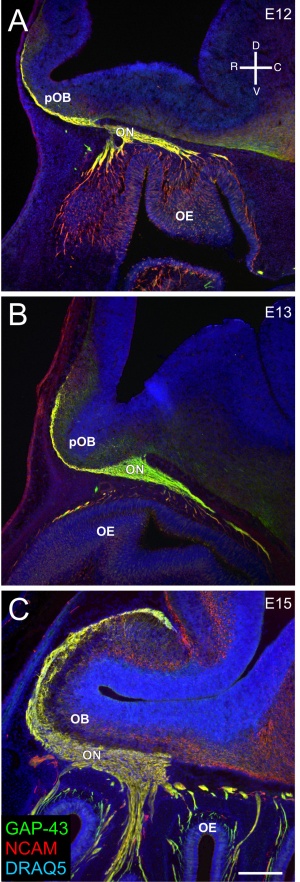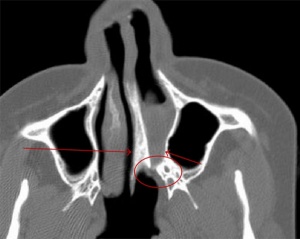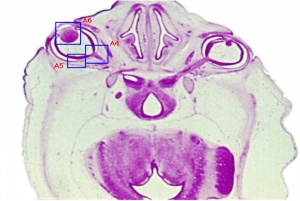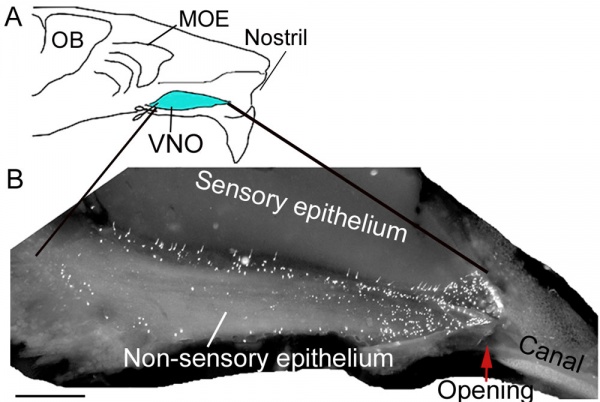Sensory - Smell Development: Difference between revisions
No edit summary |
|||
| Line 20: | Line 20: | ||
==Stage 22== | ==Stage 22== | ||
[[File:Stage_22_image_103.jpg|thumb|300px|Nasal epithelium development (stage22)]] | |||
[[File:Stage 22 image 209.jpg|600px]] | [[File:Stage 22 image 209.jpg|600px]] | ||
Revision as of 11:49, 20 August 2011

Introduction
These notes introduce the development of the sense of smell or olfaction: nasal placode, olfactory epithelium, olfactory bulb, vomeronasal organ. Recent research has shown a relationship between what the receptive epithelium is exposed too and how the central neural pathway develops, similar to that shown earlier for the visual system.
A French research group has recently been investigating the development of smell in the fetus and in neonates. The nasal epithelium has also been a researh "hot topic" as it is one of the few easily accessible sites of adult neural stem cells. Note the different spellings "odour" (UK) or "odor" (USA). Anosmia is the term used to describe having no sense of smell. Anosmia/hyposmia is related to the absence or hypoplasia of the olfactory bulbs and tracts.
| Smell Links: Introduction | placode | Rhinencephalon | head | respiratory | Student project | taste | sensory | Category:Smell | ||
|
| Rhinencephalon | Sensory - Taste Development
Some Recent Findings
|
Olfactory Receptors
Odours bind to and activate olfactory receptors located on the dendrites of sensory neurons in the nose and how the mitral cells of the olfactory bulb (OB) process olfactory information. What has yet to be thoroughly described is how the piriform cortex receives and transforms information arriving from the OB via the lateral olfactory tract (LOT). Although the cell types present in the piriform cortex are known (Shepherd, 2004), previous work has failed to differentiate between disparate electrophysiological profiles and synaptic contacts made between principal cells.
Stage 22
Olfactory Pathway

Olfactory receptor neurons (ORNs) - odours bind and activate olfactory receptors located on dendrites of sensory neurons in the nose.
Olfactory bulb (OB) - Mitral cells process olfactory information (encoded in a chemotopic map).
Lateral olfactory tract (LOT) - pathway to cortex.
Primary olfactory cortex (= Piriform cortex) - receives and transforms information.
Vomeronasal Accessory Olfactory System
Adult Mouse VMO anatomical position and showing also solitary chemosensory cells[5]
The vomeronasal accessory olfactory system (vomeronasal organ, VNO) is involved in detecting and transfering pheromone information through the vomeronasal nerve (nervus vomeronasalis) to the neuroendocrine hypothalamus. This signaling pathway can be used for mating and as olfactory cues for nocturnal animals. There are two families of receptors located in the vomeronasal organ the V1Rs and the V2Rs, are thought to detect pheromonal signals. [6]
Human embryos also have a vomeronasal organ, though later many structures such as the vomeronasal nerve, accessory olfactory bulb and chemoreceptor cells within the organ are lost. Therefore it is not clear whether there is any postnatal neuroendocrine role for this structure.[7]
Grueneberg Ganglion
The Grueneberg ganglion[8] "Within the nasal epithelium of mammals, there are several compartments which are populated with neuronal cells. One of them - the so-called Grueneberg ganglion - is composed of ciliated neurons residing in the anterior region of the nose."
Abnormalities
Anosmia
Term used to describe having no sense of smell. Anosmia/hyposmia is related to the absence or hypoplasia of the olfactory bulbs and tracts.
Kallmann Syndrome
- A developmental disease affecting both the hormonal reproductive axis and the sense of smell.
- Affected individuals have mutations in either of two different genes KAL1 and FGFR1 (20%) and prokineticin receptor-2 (PROKR2) or prokineticin-2 (PROK2) genes (10%).
Choanal Atresia

- Choanal atresia is the most common form of congenital nasal obstruction, usually diagnosed at birth.[9]
- failure of the posterior nasal cavity (choanae) to communicate with the nasopharynx.
- unilateral or bilateral bony membranous septum located between the nose and the pharynx.
- occurs in approximately 1 in 5000 to 7000 live births.
- Thought to be secondary to an abnormality during the rupture of the buccopharyngeal membrane in the embryological period.
References
- ↑ <pubmed>21441906</pubmed>
- ↑ <pubmed>21041441</pubmed>| J Cell Biol.
- ↑ <pubmed>20624980</pubmed>
- ↑ <pubmed>20723208</pubmed>| Neural Dev.
- ↑ <pubmed>20689832</pubmed>| PLoS One.
- ↑ <pubmed>20844586</pubmed>| PLoS One
- ↑ <pubmed>16487792</pubmed>
- ↑ <pubmed>20503179</pubmed>
- ↑ 9.0 9.1 <pubmed>21772853</pubmed>
Reviews
<pubmed>20502748</pubmed> <pubmed>20387075</pubmed> <pubmed>19172161</pubmed> <pubmed>18808328</pubmed> <pubmed>18809492</pubmed>
Articles
Search PubMed
Search Pubmed: Smell Development | olfactory receptors | Olfactory bulb development | anosmia
External Links
External Links Notice - The dynamic nature of the internet may mean that some of these listed links may no longer function. If the link no longer works search the web with the link text or name. Links to any external commercial sites are provided for information purposes only and should never be considered an endorsement. UNSW Embryology is provided as an educational resource with no clinical information or commercial affiliation.
Terms
- olfactory glomeruli - spherically shaped regions of neuropil where information is passed from sensory neurons to postsynaptic neurons.
Glossary Links
- Glossary: A | B | C | D | E | F | G | H | I | J | K | L | M | N | O | P | Q | R | S | T | U | V | W | X | Y | Z | Numbers | Symbols | Term Link
Cite this page: Hill, M.A. (2024, April 19) Embryology Sensory - Smell Development. Retrieved from https://embryology.med.unsw.edu.au/embryology/index.php/Sensory_-_Smell_Development
- © Dr Mark Hill 2024, UNSW Embryology ISBN: 978 0 7334 2609 4 - UNSW CRICOS Provider Code No. 00098G


